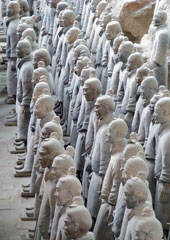China: Empire Building in the Age of Globalization
How has China systematically taken advantage of U.S. mistakes and policies?
April 17, 2013

China is replacing its main economic rivals around the world largely without the use of force. China’s success marks the first case of empire building in the age of globalization.
The United States helped China’s economic ascendance by promoting globalization and embracing, in recent years, a free market orthodoxy. In the annals of history, it will be noted that it was the United States itself that championed a new economic structure which ultimately undermined its own position in the world.
How did this happen? China’s decision to open its economy to the world coincided with the U.S. drive for globalization. U.S. and Western corporations opened the economic floodgates to China through direct investment and subcontracting agreements. As Western capitalism globalized, China became the factory of the world.
Meanwhile, its free market ideology and obsession with balancing the budget became policy straightjackets that hobbled the United States’ ability to spend strategically on its future. As a result, money that could have been spent on education, research and development, modern infrastructure and other requisites for out-competing its rivals was in short supply.
Unencumbered by a free market orthodoxy, the Chinese opted for the opposite choice. They poured resources into areas pivotal for building a robust and competitive economy. China became the unintended winner of the limits of the United States’ free market ideology.
Using its new economic strength, China has been spending its way to the top, displacing the United States in many corners of the world.
China has already surpassed the United States as Africa’s largest trading partner. Since 2005, China has spent more than $56 billion in sub-Saharan Africa, with significant investment in oil, platinum, copper, nickel and manganese and other extractive industries. China’s bilateral trade with African countries rose from $10 billion in 2000 to $125 billion in 2010. It will reach $300 billion by 2015.
China has also been aggressively encroaching into Latin America, once considered a backyard of the United States. China’s trade with Latin America increased by 1,500% between 2000 and 2010. Through loans and foreign direct investment, China is making major inroads into Latin America’s energy and extractive industries. Chinese direct investment in Latin America and the Caribbean reached $15 billion in 2010.
China is currently the largest trading partner of Brazil, Chile and Peru — and the second largest trading partner of Argentina. China has major oil deals with Venezuela, Ecuador and Brazil, and has signed free-trade agreements with Peru, Chile and Costa Rica.
Meanwhile, China has been among the main beneficiaries of the United States’ increasing militarization of conflicts in other strategic regions of the world. The United States spent nearly $940 billion in Afghanistan since 2001.
Afghanistan is estimated to be sitting on $1 trillion worth of underground resources, including copper and lithium. China is a prime candidate for exploiting and developing these resources.
In 2007, Afghanistan awarded China the right to develop the Aynak copper field in the Logar Province, the largest undeveloped copper deposit in the world. In 2011, China signed its first oil deal with Afghanistan.
These projects are just the dress rehearsal for more lucrative opportunities for investment in rebuilding the war-torn country, as well as more resource development contracts after the NATO pullout in 2014. While the United States lost billions of dollars in Afghanistan and faces increasing hostility and resentment from the Afghan people, the Chinese are entering the country with a clean slate.
China is also among the primary winners of Western sanctions against Iran. Sanctions, and barring Iran from the SWIFT banking system and trade in dollars, provided China with an accidental and strategically significant opportunity. As its top trading partner, China is currently purchasing 440,000 barrels of oil per day from Iran, all paid for with yuan.
For many years now, China has been trying to elevate the global standing of the yuan and break the monopoly of the U.S. dollar as the currency of choice in settling international accounts. The recent trade deals with Iran showcased the yuan’s potential as an international currency.
China has also been using the BRICS and other regional alliances to increase its economic and political influence in areas traditionally dominated by the United States. In the past ten years, the Shanghai Cooperation Organization (SCO) has become the primary vehicle to serve China’s growing influence in Central Asia and the wider Middle East.
Iran enjoys an observer status in the SCO. It is only a question of time before it becomes a voting member. Since 2012, Afghanistan has had observer status. Pakistan and India also have observer status and are seeking full membership in the SCO.
Turkey was granted dialogue-partner status in 2012, giving rise to speculation that Turkey might be slowly shifting its sights to SCO membership as a replacement for its thwarted ambition to join the European Union.
Whether in Latin America, Africa or the Middle East, China may have only an incidental interest in helping the peoples and economies of its trading partners. However, through its trade and investment activities, China is achieving what the West has often acquire only by force in the past. Just as globalization has limited the utility of the old methods of empire building, China is emerging with a new model.
Takeaways
Just as globalization has limited the utility of the old methods of empire building, China is emerging with a new model.
China has become the unintended winner of the limits of the United States' free market ideology.
China is aggressively moving into Latin America, once considered a backyard of the United States.
China benefits from the United States' increasing militarization of conflicts in strategic regions around the world.
The United States faces increasing hostility from the Afghan people. The Chinese enter the country with a clean slate.

